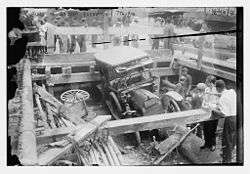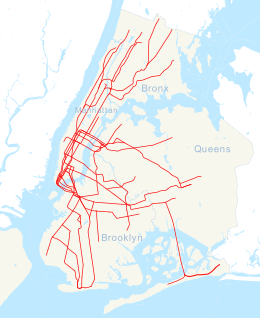23rd Street station (IRT Broadway–Seventh Avenue Line)
23rd Street is a local station on the IRT Broadway–Seventh Avenue Line of the New York City Subway. Located at 23rd Street and Seventh Avenue in Chelsea, Manhattan, it is served by the 1 train at all times and by the 2 train during late nights.
23 Street | |||||||||||
|---|---|---|---|---|---|---|---|---|---|---|---|
Downtown platform | |||||||||||
| Station statistics | |||||||||||
| Address | West 23rd Street & Seventh Avenue New York, NY 10011 | ||||||||||
| Borough | Manhattan | ||||||||||
| Locale | Chelsea | ||||||||||
| Coordinates | 40.744°N 73.996°W | ||||||||||
| Division | A (IRT) | ||||||||||
| Line | IRT Broadway–Seventh Avenue Line | ||||||||||
| Services | 1 2 | ||||||||||
| Transit connections | |||||||||||
| Structure | Underground | ||||||||||
| Platforms | 2 side platforms | ||||||||||
| Tracks | 4 | ||||||||||
| Other information | |||||||||||
| Opened | July 1, 1918 | ||||||||||
| Station code | 320[1] | ||||||||||
| Wireless service | |||||||||||
| Opposite-direction transfer available | No | ||||||||||
| Traffic | |||||||||||
| Passengers (2019) | 4,627,755[3] | ||||||||||
| Rank | 102 out of 424[3] | ||||||||||
| Station succession | |||||||||||
| Next north | 28th Street: 1 | ||||||||||
| Next south | 18th Street: 1 | ||||||||||
| |||||||||||
| |||||||||||
| |||||||||||
History
The Dual Contracts, which were signed on March 19, 1913, were contracts for the construction and/or rehabilitation and operation of rapid transit lines in the City of New York. The contracts were "dual" in that they were signed between the City and two separate private companies (the Interborough Rapid Transit Company and the Brooklyn Rapid Transit Company), all working together to make the construction of the Dual Contracts possible. The Dual Contracts promised the construction of several lines in Brooklyn. As part of Contract 4, the IRT agreed to build a branch of the original subway line south down Seventh Avenue, Varick Street, and West Broadway to serve the West Side of Manhattan.[4][5][6]
The construction of this line, in conjunction with the construction of the Lexington Avenue Line, would change the operations of the IRT system. Instead of having trains go via Broadway, turning onto 42nd Street, before finally turning onto Park Avenue, there would be two trunk lines connected by the 42nd Street Shuttle. The system would be changed from looking like a "Z" system on a map to an "H" system. One trunk would run via the new Lexington Avenue Line down Park Avenue, and the other trunk would run via the new Seventh Avenue Line up Broadway. In order for the line to continue down Varick Street and West Broadway, these streets needed to be widened, and two new streets were built, the Seventh Avenue Extension and the Varick Street Extension.[7] It was predicted that the subway extension would lead to the growth of the Lower West Side, and to neighborhoods such as Chelsea and Greenwich Village.[8][9]

On September 22, 1915, there was an explosion during construction of the 23rd Street subway station that caused the tunnel to collapse. Seven people were killed after a blast of dynamite in the subway tunnel destroyed the plank roadway over Seventh Avenue. As a result, a crowded trolley car, and a brewery truck fell into the excavation, accounting for most of the injuries.[10]
23rd Street opened as the line was extended south to South Ferry from 34th Street–Penn Station on July 1, 1918, and was served by a shuttle.[11] The new "H" system was implemented on August 1, 1918, joining the two halves of the Broadway–Seventh Avenue Line and sending all West Side trains south from Times Square.[12] An immediate result of the switch was the need to transfer using the 42nd Street Shuttle in order to retrace the original layout. The completion of the "H" system doubled the capacity of the IRT system.[8]
This station was renovated in the 1990s.
Station layout
| G | Street level | Exit/entrance |
| P Platform level |
Side platform | |
| Northbound local | ← ← | |
| Northbound express | ← | |
| Southbound express | | |
| Southbound local | | |
| Side platform | ||
This underground station has two side platforms and four tracks. The two express tracks are used by the 2 and 3 trains during daytime hours.
Both platforms have their original mosaic trim line and name tablets of a predominately brown and red color. They also have brown-red i-beam columns at regular intervals with alternating ones having the standard black and white number plate except at either end where they get narrower.
Exits
Each platform has one same-level fare control area in their center and there are no crossunders or crossovers. The northbound platform has the station's full-time turnstile bank and token booth and two staircases going to either eastern corners of 23rd Street and Seventh Avenue. The southbound platform has an unstaffed set of turnstiles and two staircases going up to either western corners of the same intersection.[13]
In popular culture
In the 1998 film Godzilla, this station was destroyed by Zilla and used as the entrance to the nesting ground inside Madison Square Garden.
References
- "Station Developers' Information". Metropolitan Transportation Authority. Retrieved June 13, 2017.
- "NYC Subway Wireless – Active Stations". Transit Wireless Wifi. Retrieved November 13, 2019.
- "Facts and Figures: Annual Subway Ridership 2014–2019". Metropolitan Transportation Authority. 2020. Retrieved May 26, 2020.
- "Terms and Conditions of Dual System Contracts". nycsubway.org. Public Service Commission. March 19, 1913. Retrieved February 16, 2015.
- "The Dual System of Rapid Transit (1912)". nycsubway.org. Public Service Commission. September 1912. Retrieved May 30, 2017.
- "Most Recent Map of the Dual Subway System Which Shows How Brooklyn Borough Is Favored In New Transit Lines". The Brooklyn Daily Eagle. September 9, 1917. p. 37. Retrieved August 23, 2016 – via Brooklyn Public Library; newspapers.com.
- Engineering News-record. McGraw-Hill Publishing Company. 1916.
- Whitney, Travis H. (March 10, 1918). "The Seventh and Lexington Avenue Subways Will Revive Dormant Sections" (PDF). The New York Times. p. 12. ISSN 0362-4331. Retrieved August 26, 2016.
- "Public Service Commission Fixes July 15 For Opening of The New Seventh and Lexington Avenue Subway Lines" (PDF). The New York Times. May 19, 1918. p. 32. ISSN 0362-4331. Retrieved November 6, 2016.
- "Subway Explosion Kills 7, Injures 85; Rips Open Seventh Av. For Two Blocks" (PDF). The New York Times. September 23, 1915. p. 1. ISSN 0362-4331. Retrieved December 19, 2013.
- "Open New Subway to Regular Traffic" (PDF). The New York Times. July 2, 1918. p. 11. ISSN 0362-4331. Retrieved November 6, 2016.
- "Open New Subway Lines to Traffic; Called a Triumph" (PDF). The New York Times. August 2, 1918. p. 1. ISSN 0362-4331. Retrieved 2020-04-21.
- "MTA Neighborhood Maps: Chelsea" (PDF). mta.info. Metropolitan Transportation Authority. 2015. Retrieved December 11, 2015.
External links
| Wikimedia Commons has media related to 23rd Street (IRT Broadway – Seventh Avenue Line). |
- nycsubway.org – IRT West Side Line: 23rd Street
- Station Reporter – 1 Train
- 23rd Street entrance from Google Maps Street View
- Platforms from Google Maps Street View



%26groups%3D_261782dfce3154b73f7364f72ac6f91a02f097fb.svg)